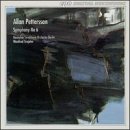| All Artists: Allan Pettersson, Manfred Trojahn, Berlin Symphony Orchestra, Deutsches Symphony Orchestra Berlin Title: Allan Pettersson: Symphony No. 6 Members Wishing: 1 Total Copies: 0 Label: Cpo Records Release Date: 3/22/1994 Genre: Classical Styles: Historical Periods, Modern, 20th, & 21st Century, Symphonies Number of Discs: 1 SwapaCD Credits: 1 UPC: 761203912421 |
Search - Allan Pettersson, Manfred Trojahn, Berlin Symphony Orchestra :: Allan Pettersson: Symphony No. 6
 | Allan Pettersson, Manfred Trojahn, Berlin Symphony Orchestra Allan Pettersson: Symphony No. 6 Genre: Classical
|
Larger Image |
CD DetailsSimilar CDs
|
CD ReviewsWaiting for Kamu Mark Shanks | Portland, OR | 01/08/1999 (3 out of 5 stars) "With the mighty Sixth symphony, Pettersson launched the series of metaphysical symphonies 6 - 9 that are the basis of his reputation. I see the Sixth as very similar in purpose to Beethoven's famous "Heiliegenstadt Testament": a cathartic expression of emotion in the wake of personal crisis. In Pettersson's case, it was the hospitalization and near death from rheumatoid arthritis and disabling side-effects that prompted this utterly personal and yet universal statement. At an hour in length, it is half-again as long as any of his symphonies written before it. It also marks a more harmonic turn in his compositions. If not exactly full of "big tunes", it is somewhat less demanding of the listener than the preceding symphonies. It was begun in 1963, when the composer was 52, but the completion was delayed by his illness until 1966. The Sixth was premiered on January 21, 1968, by Stig Westerberg conducting the Swedish Radio Symphony Orchestra.The symphony is in a single movement, but divides into two sections, separated by a chorale in the brass (where Trojahn, to my ears, muffs it the worst). I've read of this work described as a "grim movement towards the sunrise", and that isn't a bad overall description. The 25-minute coda is essentially nearly endless repetitions of one of Pettersson's "Barefoot Songs" titled "He can put out my little light" (guess who He is....) This is one of the longest of Pettersson's 16 symphonies, and certainly one of the most emotionally draining. BUT - it is NOT a "depressing" experience; it offers a cathartic experience unlike anything I know in the 20th century repertoire. In a sense, it is a trip through the seven stages of grief, ending with a sense of overwhelming acceptance (NOT resignation) that rivals Mahler's "Abschied" from "Das Lied von der Erde".This CD is the only currently available recording of the Sixth, recorded in May, 1993. The other was by Okku Kamu leading the Norrköping Symphony Orchestra on European CBS (CBS Masterworks 76553, a LONG out-of-print European LP). This latter was recorded live at a performance on April 11, 1976, and some irritating coughs were left intact. Unfortunately, it is also a superior performance. Trojahn allows too many details to become overwhelming at the expense of the overall coherency, and at 60:38, he is over 7 minutes longer than Kamu's 53:20. I suppose that we should be grateful for ANY recording of the Sixth on CD, and Trojahn has his moments, but I urge the reader to try and obtain the Kamu. Rumor has it that CBS had lost the master tape of the Kamu, but has now "found" it. Who knows.....? In the meantime, until Segerstam gets off his duff and records this for BIS, cpo has the ONLY version in town. If you can't come by the Kamu, I really would say "PLEASE try this, for the health of your soul"." A journey from despair to acceptance Daniel R. Greenfield | Milwaukee, Wisconsin, United States | 08/02/2002 (5 out of 5 stars) "It's extremely difficult to write a review of any of Allan Pettersson's symphonies -- they are such deeply personal statements. All of his symphonies present different views into his dark, inscrutible psyche. Even though he did not write programmatic music, his symphonies were mostly autobiographical in nature, reflecting the inner world of his psyche at a particular period of his life. The sixth symphony is perhaps the most cathartic of Pettersson's symphonies. Having been composed during the time when he first became severely disabled from arthritis, it represents the interior journey of a deeply distraught soul. This journey traverses a desert of despair, passing through a further region of earnest searching and reflection, finally ending in a place of profound acceptance. As in many of Pettersson's other symphonies, this work is composed of one long movement: All three stages of this journey are seemlessly woven together into a single tapestry. As such, the whole is greater than the sum of the parts. It is the entire vista that is opened up by the journey, not the individual elements of which it is composed, that creates an emotional impact on the listener. The symphony begins softly yet deeply disturbed, troubled, almost despairing. Existence is portrayed as evil and menacing. It is the dark night of the soul. But about halfway through the work the mood begins to shift: An earnest search for meaning begins. The sense of despair and frustration is put away. There is now reflection amidst the tremors of life; an earnest struggle to come to terms with existence. A disconsolate motif (eight long notes) is repeated frequently, and the tone gradually becomes more sullen and elegiac. Finally, during the last ten minutes, the mood shifts once again into one of resolution. A beautiful anthem slowly develops which is reassuring, positive, accepting: Life is good, despite the presence of suffering. As Peter Gülk, the conductor who premiered this work wrote: "The 'lyrical islands' occuring in the sixth ... are something like a glimpse of a patch of sky ... amidst a character of insistent lament."" Another great sym paul best | new orleans | 01/14/2006 (5 out of 5 stars) "From this great master of symphonic form.
Read the reviews above for better review than I am able to give, also look at my other reviews on AP syms. Also if there are other Pettersson fans out there please feel free to PM me, my email is in my portfolio. Like to hear how you stumbled upon this late 20th century master, a true heir to Shostakovich , as was Schnittke. Lastly would like to say that after yrs of trying to understand Sibelius syms, buying set after set, (5 in all!!), I gave up. Then a few months went by and I discovered Pettersson from my healthy picqued curiosity, and it was like heaven and earth opened up. Here at last was a symphonist I was longing and in search for. Sibelius had too strong a connection to that heavy germanic world reaching to Beethoven. Pettersson has slight links to that realm with slight influences from Mahler, but far surpasses Mahler in both density and structure. EDIT: Pettersson fans, go over to amazon.UK and take a look, a very close reading of the only review of sym 6 there, by hopkins105/Venice,Italy. Now read carefully what he says. There is much truth in what he darkly yet with pugnant eloquence. This guy really has a grasp of the emotional content of Pettersson. And by the way, he is correct when he says in essense there are many who just HATE Pettersson's music. Recall just how much any great man of religious faith was absolutely hated. Visionay spiritual insight is always hated by a certain group. Trust me I've felt the hate towards Pettersson, directed at me by members of a chat group I once belonged on. EDIT: April 20,2007 Look at my comments on the 6th at my review of the complete set on CPO. " |

 Track Listings (1) - Disc #1
Track Listings (1) - Disc #1
